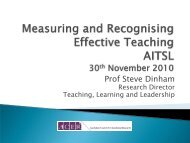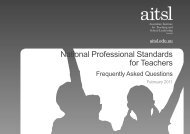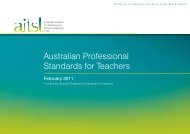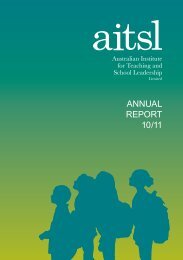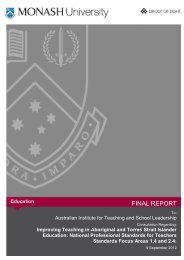Professional Learning Flagship Program: Leading Curriculum Change
Professional Learning Flagship Program: Leading Curriculum Change
Professional Learning Flagship Program: Leading Curriculum Change
You also want an ePaper? Increase the reach of your titles
YUMPU automatically turns print PDFs into web optimized ePapers that Google loves.
In secondary schools, teacher leaders are often faculty or department heads, and research hasanalysed the nature and requirements of these roles (Busher and Harris 1999; Feist 2008; Hannay andRoss 1999), pointing to the significance of the personal and professional identities of their members,their interactions, and their values about teaching. The challenge here is often to find ways of generatingsustainable teams among large and often diverse groups of people within a hierarchical organisation.Feist (2008, p. 62) quotes Thrupp and Willmott (2003, p. 181) that this is ‘difficult to organize in amanagerialist context which favours a chief executive model of leadership and where workloadsare intensifying’. Feist (2008) found that department heads prioritised their work around supportingteachers in their classroom roles in a collegial way, but that principals often gave more emphasis to themanagement aspects of the role. Hannay and Ross (1999) note that heads may experience role conflictin promoting change while at the same time protecting what they see as successful existing practice.Finally, Ward and Parr (2006, p. 126) identified challenges for teacher leadership in participating inonline distributed leadership communities, which they conclude ‘will work only where there is a sharedinterest or purpose strong enough to connect otherwise disparate groups of people and as such riskbeing transitory in nature as interests and purposes change’. Teachers in the study seemed to seetheir involvement as going beyond their primary professional role, so that sustenance of the onlinecommunity was not a priority. Ward and Parr (2006, p. 127) conclude that successful communitiesrequire ‘norms of collaboration, critical discourse, and collective responsibility’ and that this would beassisted by ‘professional development aimed at developing their leadership capacity, their ability tocreate a community and their ability to facilitate sharing in an online world’.<strong>Curriculum</strong> leadershipWhile the literature on teacher leadership includes important elements of curriculum leadership, thenotion of curriculum leadership needs further clarification in its own right.The earliest work to address aspects of curriculum leadership was based on the idea of instructionalleadership (Robinson 2010). However, this was not an adequate base for curriculum leadership, fortwo reasons. First, instructional leadership tends to take the curriculum as given, so that it focuses onimplementation at the classroom level rather than the prior and more fundamental task of developingschool programs which emphasise deep learning, inclusive and authentic learning experiences andcoherently aligned learning and assessment programs. Second, like most of the early literature, much ofthe instructional leadership literature was aimed at the principal. Nonetheless, the work on instructionalleadership is very relevant to the role of curriculum leader.A typical statement of instructional leadership comes from Brundrett and Rhodes (2010, p. 60), whostate that:Instructional leaders talk to teachers about teaching, encourage collaboration between teachers,empower teachers to make decisions, and encourage professional growth, teacher leadership,autonomy and self-efficacy ... Successful instructional leaders are able to encourage thoseconditions that can constitute a professional learning community of students and teachers.Noting that the move to distributed leadership has spread the obligations for curriculum leadershipbeyond the principal, Brundrett and Rhodes (2010, p. 105) identify characteristics of a school faculty ordepartment culture which would encourage continuous improvement. It follows that curriculum leadersshould contribute to the development of teams and departments which have these characteristics.<strong>Curriculum</strong> leaders need to develop curriculum teams and departments characterised by:• shared values and beliefs• moral purpose linked to a focus on learning and learners• sharing, collaboration and co-operation• enquiry, reflection and evaluation• criticality and involvement27 <strong>Professional</strong> <strong>Learning</strong> <strong>Flagship</strong> <strong>Program</strong>: <strong>Leading</strong> <strong>Curriculum</strong> <strong>Change</strong>: Literature Review





